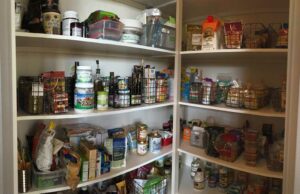 Autumn is a great time to clear out the pantry and make room for fall foods, baking supplies and entertainment planning items. A fresh pantry will reignite your love for cooking and give your kitchen a little refresh. Clearing out and inventorying the food in your pantry can help with your meal planning and grocery shopping. We have put together four simple, practical tips for getting your pantry organized this fall.
Autumn is a great time to clear out the pantry and make room for fall foods, baking supplies and entertainment planning items. A fresh pantry will reignite your love for cooking and give your kitchen a little refresh. Clearing out and inventorying the food in your pantry can help with your meal planning and grocery shopping. We have put together four simple, practical tips for getting your pantry organized this fall.
- Remove all food and other items from your pantry
You will also want to gather food you have stored in other areas of your home. While the pantry is empty, it’s a great time to thoroughly clean all surfaces for a fresh start. Ahead of this project, consider purchasing the food you typically keep on hand. This is an important part of allocating adequate space in your pantry.
- Sort and categorize your food
During this process, you can categorize the food on your kitchen countertops and dining room table. Remove and dispose of expired food. Relocate nonfood items, especially if your pantry space is limited to another storage area of your kitchen or home. Categorize your food into snacks, canned goods, grains, pastas, nuts & seeds, etc.Strategize where food will go in your pantry based on the categories, quantity of food and convenience. You will want frequently used items within reach. Occasionally used items can go on higher, less convenient shelves. You may or may not want kids snack items within their reach.
- Purchase storage products
If you need them, explore and purchase storage containers that will work well for your pantry. Clear bins work great for corralling snack bars, chips and items that come in soft packaging. If you tend to purchase bulk grains, nuts, etc., you may want to consider tight sealing, clear containers for storage of these items that do not come with their own packaging. Measure your space carefully prior to buying storage items, as you want them to fit well in the space they will be used.Also be careful not to overcomplicate containers. Many times, placing pre-packaged food into containers may be more work than needed. Consider food rotation when deciding on containers. You will want to make sure the older food gets used first. Coordinating containers can make the pantry aesthetically pleasing.I also suggest labels for all containers. This will help ensure everyone knows where to return food to the pantry. Adding pull out drawers and baskets are nice for deep shelves to make all items visible and accessible. You can utilize the pantry doors for storage of lightweight, narrow items.
- Return food to pantry
Returning food to the pantry is fun. This is where you get to utilize any new storage products, decide on the best location for the food, and label the bins and containers. Remember that food goes with food in the pantry. Non-food items go with non-food items, and may need to be stored in other areas. The slow cooker you use two times per year, the holiday candles, or kids craft supplies may not have a home in your pantry, especially if you are low on space. Limit food storage in other areas such as the hall closet, bathroom, garage, and basement unless necessary.
Bonus Step: Create a meal plan that utilizes the food you have in your pantry. This will save you cash on your next shopping trip.
Pantry organizing can be a fun and easy organizing project that is good to do with the season changes. For a kick start on organizing your pantry, see if Top Shelf Home Organizing can help you. Contact Jayme for advice. We love what a fresh pantry will do for you.
